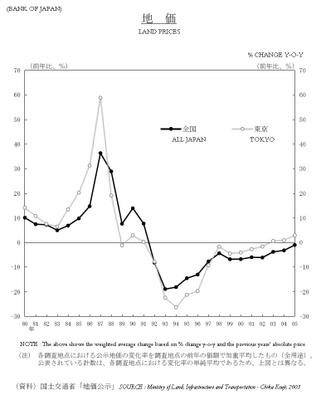Land Prices in Tokyo Rise for First Time in 15 Years
New official data last week showed that land prices in Tokyo have picked up for the first time in 15 years, fueled by strong demand for office space and the flow of investment funds into the real estate market (readers subscribed to our mailing list will already be aware of this). Property prices in Tokyo's 23 wards as of July 1 were up 0.5% on average from 2004 in residential areas and 0.6% in commercial zones. The number of areas exhibiting higher prices also expanded in Osaka and Nagoya, providing evidence that property values have stemmed their decline in major urban areas and are starting to trend upward (Nikkei, Bloomberg).
The Nikkei further reports : “In Tokyo, Nagoya and Osaka, 520 areas saw price increases, up dramatically from 80 last year. Areas that halted their slides or remained flat accounted for 20% of the total, up from 4.4% last year. This bottoming out was particularly remarkable in the Tokyo metropolitan area, where prices rose not only in central wards such as Chiyoda, Minato and Shibuya but also in areas outside the main Yamanote train line …In two spots near JR Nagoya Station, prices jumped more than 30%, reflecting the surging demand associated with ongoing redevelopment projects there.”
Déjà vu? Well, there were similar announcements last year and in April this year, but the gist is that the positive data has expanded beyond a few prime areas, and now the average for all points surveyed in Tokyo shows an increase. Land prices in other parts of Japan, however, have little chance of following suit, due to shrinking regional populations and deindustrialization. Some economists argue that this is to be expected, and is actually better for the country.
I think the data is best viewed as a lagging indicator, because this years’ figures are based on transactions in the past year. One should note also that the recent land-price announcement refers to the simple average of all points in Tokyo. As Mr. Yoichi Takita of the Nikkei Shimbun points out, if one looks at the trend for the weighted average for the same Tokyo locations, the upturn appears two years ago, and growth has been increasing, by 0.6% in 2003, 0.9% in 2004 and 2.9% in 2005.
 This means that the most expensive locations in Tokyo had in fact already bottomed around three years ago! This coincides with the first round of investment funds into Japan and the start of the J-REIT’s dominance in prime property purchases.
This means that the most expensive locations in Tokyo had in fact already bottomed around three years ago! This coincides with the first round of investment funds into Japan and the start of the J-REIT’s dominance in prime property purchases.Now, real estate investors are struggling to locate good investments in Tokyo, as competition forces yields down; investors are forced to seek properties in regional towns. Savvy investors like Babcock and Brown have already locked in their gains by buying Tokyo properties two to three years ago. That doesn’t mean people coming in now have missed the boat, though – the market is deep, and there will be many more properties coming out of the woodwork now that the tide has turned (basically the government is saying, “time to sell, folks!”). Just don’t expect many bargains in central Tokyo.
Japan Real Estate / Property Investment Blog

0 Comments:
Post a Comment
<< Home